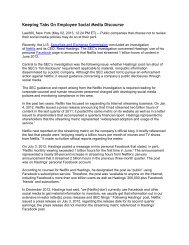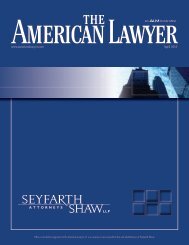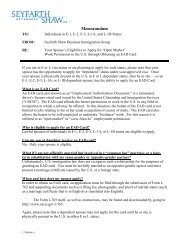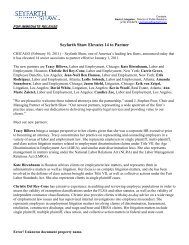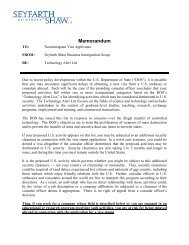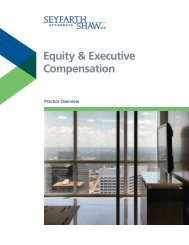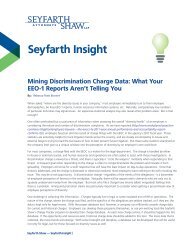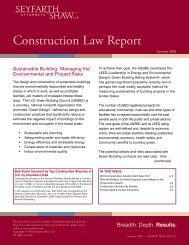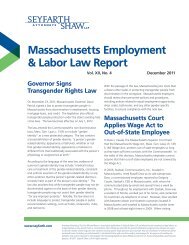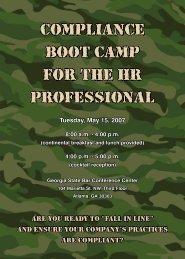Litigating California Wage & Hour and Labor Code Class Actions
Litigating California Wage & Hour and Labor Code Class Actions
Litigating California Wage & Hour and Labor Code Class Actions
Create successful ePaper yourself
Turn your PDF publications into a flip-book with our unique Google optimized e-Paper software.
nothing but still are bound by the class release. Those class members who do not request<br />
exclusion will also have the option of filing an objection to the settlement. 472<br />
After a fixed period following the issuance of notice (usually 45-60 days), the claims period<br />
will end, <strong>and</strong> class counsel will seek final approval of the settlement. Above <strong>and</strong> beyond<br />
the analysis the court conducted at preliminary approval, the court will examine the extent<br />
of class participation in the settlement, will rule on any objections, <strong>and</strong> will make final<br />
determinations as to class counsel’s request for attorney’s fees <strong>and</strong> an incentive payment<br />
or “enhancement” for the class representative (additional money beyond that received by<br />
other class members as a reward for taking the risk of filing the class action).<br />
When <strong>Labor</strong> <strong>Code</strong> class actions were relatively novel, there was little consistency between<br />
different judges as to the scrutiny of settlements they would undertake or the rules they<br />
would apply. Most courts who did not have much experience with class actions typically<br />
undertook very little scrutiny of class settlements beyond ensuring that they were not<br />
collusive <strong>and</strong> that the notice provided clear instruction to the class. Over the intervening<br />
years, however, a substantial body of law has developed to provide courts with better<br />
guidance as to how to evaluate class settlements in wage <strong>and</strong> hour cases.<br />
B. Restrictions on Reversions of Settlement Funds<br />
Most class settlements are the product of mediation. Unlike a court, which must protect the<br />
interests of a class, a mediator seeks solely to broker a settlement acceptable to the parties<br />
who hired the mediator—i.e., the lawyers for the parties. Irrespective of their fealty to<br />
ethical obligations, plaintiffs’ counsel—who often have near absolute control over<br />
wage/hour class litigation—have a financial interest in maximizing the attorney’s fees they<br />
will receive through the settlement. The employers’ financial incentive is to achieve as<br />
broad of a release as possible for as little money as possible. Because the plaintiff’s lawyer<br />
typically receives an attorney’s fee that is a percentage on the gross value of the class<br />
settlement, employers would commonly agree to a nominally larger gross settlement value<br />
on the condition that any unclaimed settlement funds be returned to the employer. These<br />
sort of “reversionary” settlements have been popular because they allowed an employer<br />
the possibility of paying substantially less in settlement than the gross settlement would<br />
suggest, particularly in industries where the employer could predict that the claims rate<br />
would be low.<br />
472<br />
See generally Wershba v. Apple Computer, Inc., 91 Cal. App. 4th 224, 251-52 (2001) (explaining different choices class<br />
members typically have upon receiving class notice). Recent case law also implies that it may be permissible to settle a<br />
certified class action through the acceptance of an offer of judgment by the class representative. See Nelson v.<br />
Pearson Ford Co., 186 Cal. App. 4th 983, 1024-26 (2010) (assuming without deciding that a valid <strong>California</strong> <strong>Code</strong> of<br />
Civil Procedure § 998 offer can be made in a certified class action). Should this process be used, after acceptance, the<br />
parties would then provide class notice, etc., just as if a stipulation of settlement had been entered.<br />
Seyfarth Shaw LLP | www.seyfarth.com <strong>Litigating</strong> <strong>California</strong> <strong>Wage</strong> & <strong>Hour</strong> <strong>Class</strong> <strong>Actions</strong> (12th Edition) 103



